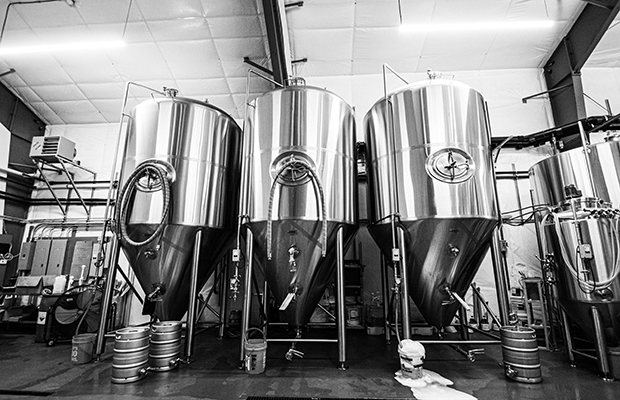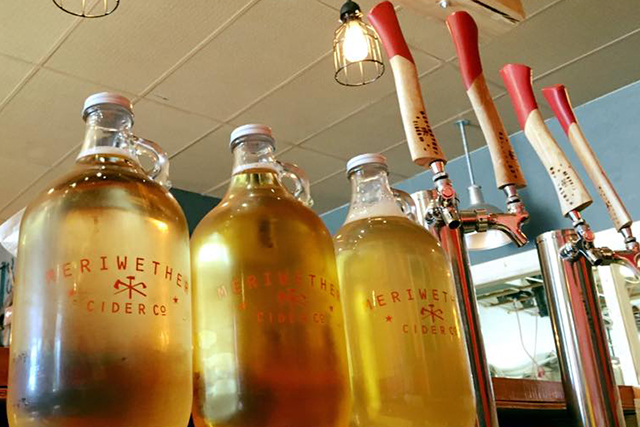
When your brewery grows faster than expected, speeding up a timetable on production can be a challenge, especially when you are space constrained. Many breweries solve this issue by building on to the existing structure they began in. Sometimes, that works for a while. Eventually, a move to a new building can be the only option or adding a second location to house a larger brewhouse is in the works. That can mean weighing the costs of fitting into a larger building that is already made or building that “dream brewery” that you had visions of from the start.
For Mast Landing, the cost of building a new facility ended up being right around the same cost had the Westbrook, Maine-based brewery looked to move into another place that was already built. The freedom to create from the ground up was enticing.
“Fortunately, where we’re located, our town kind of has this little concentrated, urban feel,” said Ian Dorsey, Mast Landing CEO. “As you get further away from the center, it gets very rural, so there’s a lot of land available that still had the major utilities already at the street level. So that helped quite a bit.
“We had access to the power, the water, the sewer, and natural gas. The really big important checkmarks.”
The downside was, construction pushed back the opening of the new 20,000 square foot production facility by about a year. But Dorsey said they knew where they wanted to go and knew of a parcel of land that they thought would be a great spot.
“We’re trying to always think several years into the future whenever possible,” he said. “That was something that we had on our radar for a while. So when we knew that we were going to kind of pivot in this direction, that was one of the first spots that we looked.“
In Lynn, Massachusetts Bent Water Brewing built a new facility as well. Already located in an industrial park area, the brewery had room 60 feet away from its first facility to add a second building to help build growth.
Co-founder Aaron Reames said what Bent Water was doing at the start was very similar to what DC Brau did, a brewery that he leaned on for advice.
“They went into an area which was a business park with individual units. And then over time, they just picked up units as they needed it,” he said. “[It’s] a little bit different than a Funky Buddha where they kind of did the same, but they ended up picking like 40,000 square feet at a time where we’re picking up 7,000 square feet at a time.
“I had spoken with those two groups as well as many other breweries, some of which picked up 80,000 square foot facilities right out of the gate. And so we wanted to, first of all, solve for the economics in a very robust real estate markets.”
One way that Beer’d Brewing solved its economic part while still building new was working with a developer for a build-to-suit location. Although it adds another layer to the complicated aspect of getting a new location planned, it worked very well for Aaren Simoncini, the brewery’s owner and founder, although there were some snags. It especially came up in the timing of opening. Although the production side is completed now, the brewery is just about to open the taproom portion more than six months after the initial plan.
“We had already pulled the trigger on equipment and everything,” he explained. “So we ended up having to pay for a lot of storage and moving and rigging things twice. It was a bit of a nightmare.
“When we finally wrapped up, I was like, OK, let’s just turn the moneymaker. We already had a taproom in our existing facility so we ended up doing that and started making beer and we just hit the pause button on opening the taproom.”
When Beer’d first started, Simoncini was looking for the same thing everybody would look for in a facility for brewing beer: Three-phase electric, city water, and city sewer.
“Being in rural Connecticut, it’s not necessarily the easiest thing to come by,” he said. “So price per square foot was important as well as all those utilities when we first kind of started looking at [the original] building. We ended up in about 2,100 square feet. Since then, we’re at about 7,000 square feet. We’ve been able to expand because of adjacent construction or whatnot. But it’s been a process because we built the original brewery in the square footage that you have and the footprint that you think would work best.
“Then it’s like, oh, well, now we’re going to open up this wall and we need to expand down this way. And that was never in the original plans. So it kind of throws the entire production flow out of whack.”
That flow was certainly something Simoncini thought about when Beer’d went to build the new building.
“What do the next steps in this current footprint kind of look like and where can we expand to in the future if that becomes necessary,” he explained, noting that the first brewery has ramps where they wish there weren’t ramps and there are staircases were they wish there weren’t staircases.
“So we tried to eliminate all of that in the new construction and kind of make sure we learn from our experiences here,” Simoncini said.
In the process of expanding and optimizing their brewery, it’s crucial for business owners like Simoncini to consider the structural integrity of their building, particularly when making significant changes to the original layout. One common issue that can arise during such expansions is the appearance of foundation cracks. These cracks can compromise the stability of the building and must be addressed promptly by experts to prevent further damage. Consulting with foundation crack specialists ensures that any issues are properly diagnosed and repaired, safeguarding the long-term durability of the structure and maintaining a smooth production flow.
For businesses looking to expand their usable space, basement lowering is an effective solution to increase square footage without the need for additional land. By lowering the basement, companies can create more room for storage, production, or other essential operations. Experts in basement lowering can assist with this complex process, ensuring that the foundation remains stable and the structural integrity of the building is maintained. Implementing such solutions allows businesses to maximize their existing footprint and plan for future growth, all while learning from past experiences to create a more efficient and practical workspace.
gImproving production flow was also vital for Bent Water, but so was integrating the two facilities into one join operation was also a key.
Bent Water Engineering Manager Jere Anderson explained that the brewhouse is in one building while the large fermenters and the packaging is in the second building.
“Yeah, we were thinking a whole lot about flow,” Anderson said. “Of course, that also means putting a central point to collect wastewater and then deal with wastewater and also put in new electrical distribution systems. Then divide both things between the two buildings. The two buildings are about 60 feet apart. Between them, it’s Swiss cheese under there. We had to drop a transformer then separate that transformer to go off in two different directions to bring power to both buildings, then have drains connecting.”
All the drains connect to a central place where Bent Water has solids removal.
“We can put much cleaner water back to the city,” Anderson said.
Reames added in a couple of cases, Bent Water actually spent a little bit more to get a payback in the future. Especially in the water treatment facility.
“We spent extra money to tie in those two buildings so that we’ve actually got one place where we can remediate all water before basically sending it back to the city,” Reames said. “That is probably an expense that most people are going to deprioritize and they’re going to get rid of it. But you really only have one chance to do it. We didn’t do it in the first build. We didn’t actually have the room to put a water treatment facility in.
“It only happens if we actually been able to grow the business to the point where we actually need that capacity. And so it’s kind of thinking ahead about, OK, this is Day One. What does it look like in three years? What does it look like in 10 years? And let’s try to map that out and plan through some of these items. I already have in my mind, the next two or three pieces of equipment already mapped out. I know where they go. I know when they’ll come in. That’ll either be based on cash flow or timeline or capacity … one of those three.”
Reames said the wastewater treatment is a good investment because it’s going to pay dividends in terms of the industrial tax.
“We are in a situation where there was no way to determine how much was going down the drain relative to how much was being used,” he said. “It just wasn’t set up that way from a metering standpoint. So we were being charged as though all the water that we used was actually going down the drain. It wasn’t accounting for the amount of beer that was going out in vessel and package.
“Also what we were able to do is really good for the environment, and good for the city. We have a mechanism now that we can remove a lot of BOD from the liquid and we can basically send it back within spec and without a treatment facility.”
Bent Water also built a much taller new building for tanks.
“Now I can get all the tanks in. I only had so much land that we could put a building on and it could only be so wide. I spent a lot of time looking at tank positioning for product flow. It was a lot of back and forth with the tank manufacturer. We could change this diameter by a foot that means I can get another tank in here, which gives me more.”
Anderson noted in a fermenter, you have certain relationships between cone angle and volumes so he pushed to go with a way that got him the most room to put them in a reasonable arrangement and still function properly.
Roughtail Brewing had a tough go of it to get the new facility opened. Blaine Stansel, the brewery’s CEO and co-founder said the Oklahoma City facility has been a slow two and a half year ordeal that was wrecked by multiple contractors and low-grade workers.
“I think the thing was not properly vetting our general contractors and who we went with,” he said.
“A lot of it just comes down to communication. And we’ve gone through like four or five people at this point. We got off the wrong foot. So I really would have done a better job of kind of looking into and asking around, talking with people. I think that some of these problems are common to all projects. But you could probably avoid some of these by doing some more research and maybe not just choosing the person is the most enthusiastic.”
One of the things that Stansel would do again was he signed a guaranteed maximum price contract (GMP).
“The guy way underbid the thing, and now we’re not out money,” Stansel said. “If you didn’t have the GMP, it would be on you. And for a small business like us, I mean, that would be killer. That bank could pull the plug at any moment. Once we got these other guys involved, the contractors going forward were all really, really good. It was a pretty crazy situation. There’s no way we could have done it ourselves. It’s too massive. There are too many moving pieces.
“You’ve got to make sure, again, the contractor has good contacts.”
Communication was vital for a smooth-running project, Dorsey said. For Mast Landing, there were little snags, but for the most part, staying in communication with the various trades working on the facility along with the general contractor help ease some pains.
“It’s really when things started to come together at the very end where you’ve got six different contractors in there and they all have their punch lists, but a lot of their stuff is kind of running into each other,” Dorsey said.“ So you have to kind of play that little sort of dance right there to make sure the electrician can get over to do what they need to do, but do it in a way that they’re not in the space that the plumber needs to be in. Definitely a lot of shifting, a lot of a dance that needs to happen there.“
The major thing that Dosey said they kept telling people and it’s since paid off for Mast Landing is to go as large as you can with your cold storage.
“One of the things that we found out was that it costs almost as much to move a walk-in cooler than it does to have a brand new one installed,” he said. “It was quite astounding, actually, to get that quote back, back when we had thought about maybe just renovating our current existing space. One of the major items we were going to have to do was to move that walk-in cooler. And we had several contractors come in and a couple of them came back with a price that was more than what the cooler cost to purchase and install the first time. So that just completely blindsided us.
“That’s something we try to tell everybody is think far into the future, as far as you can with your cold space, put it in a location that will be convenient and go make sure you are putting it in as large as you can budget for with where you think you might be going in the future.”
Simoncini also jokingly warned that a key takeaway is don’t share a deadline or a timeline with the public.
“I’ve had to answer the question for a year now,” he said with a laugh. “It’s been frustrating because everybody is kind of anticipating it and they’re very excited. That’s great. And you definitely want to be able to feed some of that down the pipeline, but it’s just not that easy to look at what could be a year-long project. So wait a little while. It’s exciting to get those Instagram photos out there and to share the business. But at the same time, you’re gonna be kicking yourself when you’re six months, seven months down the road from timelines.”






1 Trackback / Pingback